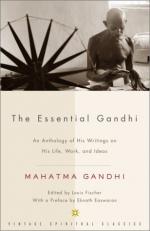
|
| Name: _________________________ | Period: ___________________ |
This quiz consists of 5 multiple choice and 5 short answer questions through Part 3: Chapters 33 and 34.
Multiple Choice Questions
1. How was Gandhi as a lawyer in Rajkot and Bombay?
(a) He never worked in Raikot or Bombay.
(b) He was not very good.
(c) He was very good.
(d) He did not practice law.
2. Gandhi's creation abandoned the eye-for-an-eye attitude in favor of what?
(a) Holding on by force.
(b) Ignoring evil doers.
(c) Returning good for evil until the evil doer is exhausted.
(d) Protest meant more to harass than enlighten opponents.
3. By the time Nehru left the ashram, Fischer could detect that Nehru was being won over, later becoming a stronger advocate of____________ than Gandhi himself.
(a) Ending the civil disobedience.
(b) The civil disobedience.
(c) Shortening the civil disobedience.
(d) Lessening the civil disobedience.
4. To achieve success in South Africa, Gandhi's most effective tool was a unique creation of his own called what?
(a) Duragraha.
(b) Ahimsa.
(c) Swadeshi.
(d) Satyagraha.
5. Why were Gandhi and one of his sons and many other Indians arrested?
(a) For protesting.
(b) For being non-registered coloreds.
(c) For not wearing the appropriate clothing.
(d) For boycotting.
Short Answer Questions
1. Gandhi had discussions about what with the jailed and jailer alike?
2. Was Gandhi's personal life as successful as his public life?
3. Gandhi called for what non-violent non-cooperation?
4. Jinnah declared what on August 16th?
5. Gandhi's philosophy was that for Indians to be treated fairly, they needed to do what?
|
This section contains 267 words (approx. 1 page at 300 words per page) |

|




